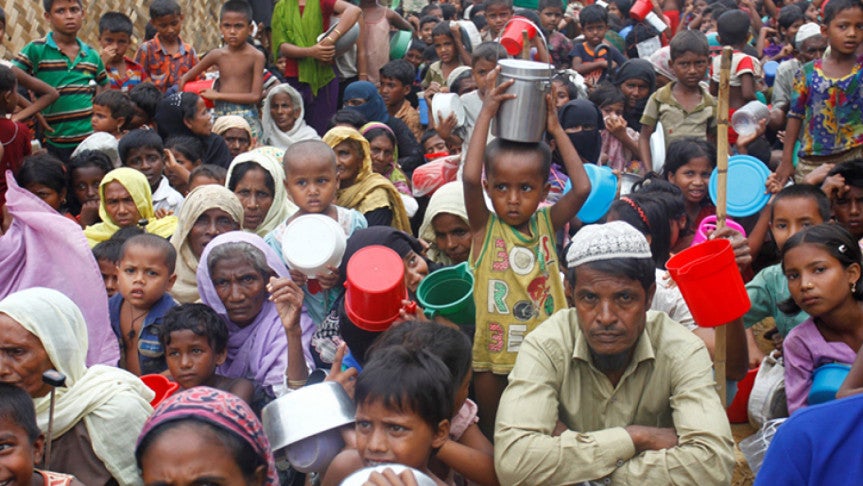Bangladesh hosts most Rohingyas from Myanmar; global displacement tops 70 mn: UNHCR

Refugees originating from Myanmar represented the fourth largest population group by country of origin and most Rohingyas from Myanmar were hosted by Bangladesh (906,600) at the end of the year 2018, says a global report on Wednesday.
However, according to government data, Bangladesh is now hosting over 1.2 million Rohingyas and most of them came since August 25, 2017, the UNB reported.
The number of people fleeing war, persecution and conflict exceeded 70 million in 2018 and this is the highest level that UNHCR, the UN Refugee Agency, has seen in its almost 70years.
By the end of 2018, this Rohingya population stood at 1.1 million, about the same as in 2017, according to data from UNHCR’s annual ‘Global Trends’ report released on Wednesday.
Most refugees from Myanmar were hosted by Bangladesh (906,600) at the end of the year, a slight decline from the end of 2017 (932,200) due to improvements in registration methods.
Other countries with sizable populations of refugees from Myanmar were Malaysia (114,200), Thailand (97,600) and India (18,800).
UNHCR’s Representative in Bangladesh Steven Corliss responded to the report urging the international community to show increased solidarity with Bangladesh.
‘The figures released today once again demonstrate the generosity of the Government and people of Bangladesh in providing safety for so many Rohingya people forced to flee their homes’, he said.
Steven Corliss said the 2019 Joint Response Plan for the Rohingya Humanitarian Crisis launched earlier this year seeks to raise US$ 920 million for the needs of the Rohingya refugees and affected Bangladeshi host communities.
‘As of today, the appeal is less than a quarter funded. This is deeply worrying given that we are approaching the second half of 2019 and have entered the annual monsoon season, with high winds and heavy rains putting refugees at risk and damaging homes almost daily,’ he said.
Steven Corliss said humanitarian agencies must receive the funding needed to continue delivering life-saving assistance and to improve conditions for refugees and host communities in Bangladesh.
Data shows that almost 70.8million people are now forcibly displaced. To put this in perspective, this is double the leve lof 20 years ago, 2.3 million more than a year ago, and corresponds to a population between that of Thailand and Turkey.
The figure of 70.8 million is conservative, in particular as the crisis in Venezuela is still only partly reflected in this number. In all, some 4 million Venezuelans have left their country since 2015 making this among the world’s biggest recent displacement crises.
Although the majority need international refugee protection, as of today only around half a million have taken the step of formally applying for asylum.
UN High Commissioner for Refugee Filippo Grandi said what they are seeing in these figures is further confirmation of a longer-term rising trend in the number of people needing safety from war, conflict and persecution.
He said while language around refugees and migrants is often divisive, they are also witnessing an outpouring of generosity and solidarity, especially by communities who are themselves hosting large numbers of refugees.
‘We are also seeing unprecedented engagement by new actors including development actors, private businesses, and individuals, which not only reflects but also delivers the spirit of the Global Compact on Refugees,’ said Filippo Grandi.
He said, ‘We must build on these positive examples and redouble our solidarity with the many thousands of innocent people who are forced to flee their homes each day.’
Within the 70.8 million figure in the Global Trends report are three main groups.
The firstis refugees, meaning people forced to flee their country because of conflict, war or persecution. In 2018, the number of refugees reached 25.9 million worldwide, 500,000 more than in 2017.
Included in this total are 5.5 million Palestine refugees who are under the care of the United Nations Relief and Works Agency.
The second group is asylum seekers - people outside their country of origin and receiving international protection, but awaiting the outcome of their claim to refugee status. At the end of 2018 there were 3.5 million asylum seekers globally.
The third and biggest group, at 41.3 million, is people displaced to other areas within their own country, a category commonly referred to as Internally Displaced People or IDPs.
Overall growth in displacement continued to exceed the rate at which solutions are being found for people who become displaced.
With refugees, the best solution is being able to return home voluntarily, in safety and dignity.
Other solutions include being integrated into the host community or being resettled to a third country.
However, only 92,400 refugees were resettled in 2018, less than 7 per cent of those awaiting resettlement. Some 593,800 refugees were able to return home, while 62,600 became naturalized.
‘With every refugee situation, wherever it is, however long it has been going on for, there has to be an enduring emphasis on solutions and removing obstacles to people being able to return home,’ said Grandi.
‘This is complex work in which UNHCR is constantly engaged but which also requires all countries to come together for a common good. It is one of the great challenges of our times.’

 NTV Online
NTV Online




